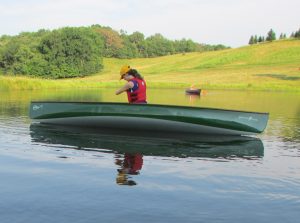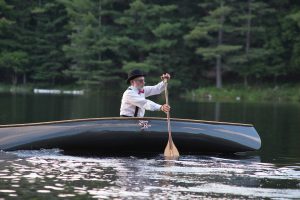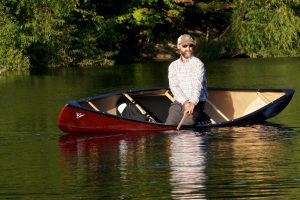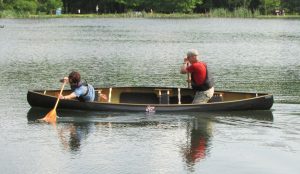By Marc Ornstein
If you’re reading this article it’s a good bet that you’ve seen a video or two where a paddler has significantly heeled (tipped) the canoe, sometimes all the way down to the rail, while executing a turn. You may have thought “OK that looks cool, but why do that? Is it just some way of making something simple look fancy- just another way of showing off?” Well a bit of that maybe, but heeling has an effect on the hull that can be very useful.
 Most canoes are designed to track (resist turning) quite well when level in the water (side to side and front to back) and paddled correctly. The keel line (length of the hull that is below the waterline) is relatively long compared to the width of the hull and it parts the water nicely as it travels forward or backwards. In general, the longer the keel line and the narrower the boat, the more efficiently this happens. Thus, racing and fast tripping canoes tend to be long and narrow, while canoes designed for maneuverability tend to be shorter and wider. Regardless of the design when one attempts to turn the canoe, the ends of the hull must push a lot of water to one side or the other and this requires additional effort.
Most canoes are designed to track (resist turning) quite well when level in the water (side to side and front to back) and paddled correctly. The keel line (length of the hull that is below the waterline) is relatively long compared to the width of the hull and it parts the water nicely as it travels forward or backwards. In general, the longer the keel line and the narrower the boat, the more efficiently this happens. Thus, racing and fast tripping canoes tend to be long and narrow, while canoes designed for maneuverability tend to be shorter and wider. Regardless of the design when one attempts to turn the canoe, the ends of the hull must push a lot of water to one side or the other and this requires additional effort.
Before beginning our turn we spent some energy getting the canoe moving; creating momentum. Any effort spent while turning the canoe, expends energy and reduces that momentum. One way of reducing that effort is to add rocker. Rocker is a curvature of the keel line from front to back. This raises the bow and stern a bit, causing the bottom shape of the hull to look in profile a bit like the rung of a rocking chair. With the ends now sitting a little higher in the water, the amount of water that needs to be pushed aside, as the boat turns, is reduced and the turning is going to be a little easier. Looking at two extremes, a typical racing canoe will have little or no rocker while a whitewater play boat will often have so much rocker that it begins to resemble a banana and is sometimes humorously referred to as such. The more rocker, the easier the boat turns. When I began canoeing, I was told that I could buy a canoe that tracked (went straight) well or one that turned well, or one that did a little of each (but wouldn’t be all that great at either). The common wisdom was that to cover my bases, from lake tripping to running rivers, I’d need a selection of canoes.
Well, not necessarily – I’m here to tell you that you can have your cake, and eat it too. You can have a single canoe that will both track nicely and also turn efficiently when you want it to. Your dream canoe. It’s one that has a fairly straight keel line when you want it to go straight but can be converted to a highly rockered canoe when you want it to turn. In fact, it may well be the canoe that you already have in your shed. Picture most any canoe, be it a tripping, touring, racing, or general purpose craft. Sit it flat on the ground or better yet, float it on a pond (if on the ground, you’ll have to use a bit of imagination). You’ll notice the keel line runs the full, length of the boat or nearly so. Now, tip the boat a bit to one side or the other. The tipped down side has now effectively become the bottom of the boat and the ends (stems) of the boat have risen higher in the water (or the imagined water). The keel line has become much shorter and the canoe suddenly has more rocker. The further you heel the boat, the greater the rocker, to the point where the stems may leave the water entirely.
 |
 |
The trick is in learning how to control that rocker. How to heel the canoe onto its side, smoothly and consistently; when, where and how far you need to; and then how to flatten it back out with the same level of control.  Generally a modest heel is sufficient to get the job done but the further you heel the boat, the greater the rocker and the less it resists turning. It even matters which way you heel it, toward or away from the turn, but that’s for another article. In other words, how you adjust your canoe to meet your needs at any moment. This can be done while sitting or kneeling, though you’ll have infinitely more control, when kneeling.
Generally a modest heel is sufficient to get the job done but the further you heel the boat, the greater the rocker and the less it resists turning. It even matters which way you heel it, toward or away from the turn, but that’s for another article. In other words, how you adjust your canoe to meet your needs at any moment. This can be done while sitting or kneeling, though you’ll have infinitely more control, when kneeling.
So, do you still think it’s just something that looks cool, that it’s a way of showing off? It is but it’s mainly about precision boat control. It’s about the ability to have a nice tracking touring boat, which at your whim, becomes rockered and turns on a dime before continuing on its journey. It’s about transforming/fine tuning your canoe, on the go, constantly.
The two videos linked below show a no frills axle (a basic turn to the on side) using a modest heel to enhance the turn. The 1st video is at normal speed while the second is at ¼ speed.
3 point axle at normal speed. https://www.youtube.com/watch?v=vhsGKTF_o0Y
3 point axle at ¼ speed. https://www.youtube.com/watch?v=NGp3sYe-Hx4
 |
 |
Just as important as rocker, is pitch. We’ll explore that in part 2 of this series. Heel and pitch can be used just as effectively in both solo and tandem canoes. In a tandem canoe, with both paddlers working in harmony, it’s a beautiful thing to experience or watch. The video that will be included at the end of part 2 of this series includes numerous demonstrations in real world settings.
Controlling rocker and pitch are key elements that are taught by FreeStyle instructors at all of our Events